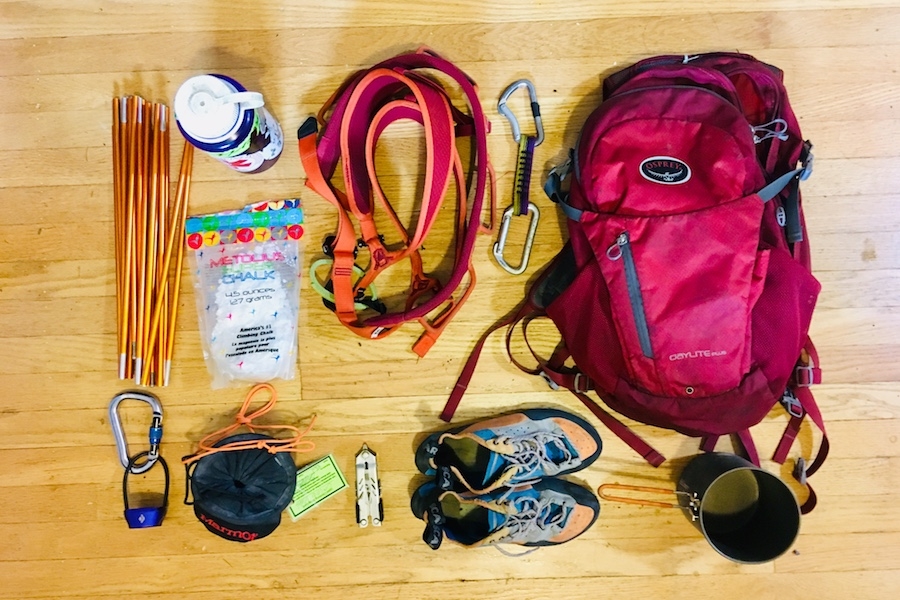Small businesses worry about unexpected price increases.
Gearing up for the next hike, ski tour or trip to the crag could cost more this year, because of the U.S.’s trade war with China.
Tariffs are making carabiners, trekking poles, backpacks and other pieces of outdoor gear more expensive, as manufacturers pass extra costs onto consumers. Within the state’s $16.4 billion outdoor recreation industry, there’s little evidence that the trade restrictions are having the effect President Donald Trump’s administration intended—reinvigorating U.S. manufacturing.
The administration plans to raise existing tariffs on $250 billion worth of Chinese goods on January 1, but Trump might seek a truce in a key meeting with Chinese president Xi Jinping this weekend.
There’s been much discussion about the effects of the trade war on Nike, Columbia Sportswear and other apparel companies with large offshore manufacturing operations. But smaller businesses feel the burden too.
“We are seeing the tariffs increasing materials substantially. Overall it’s been quite detrimental to some of our product lines.”
—Brooke Sandahl, VP, Metolius Climbing
“We are seeing the tariffs increasing materials substantially,” Brooke Sandahl, vice president of Metolius Climbing, wrote in an email. “Overall it’s been quite detrimental to some of our product lines.”
The Bend-based manufacturer makes carabiners, quickdraws, cams and other safety gear for climbing. The products require a lot of steel and aluminum, inputs that have jumped 25% under the tariffs. Other seemingly random items, like materials used for belay glasses (used to turn vision 90-degrees upward to reduce neck strain), have fallen under tariffs.
Sandahl says the company absorbed part of the cost in its margins, but raised prices on some of its gear. The company only changes prices every half year or year, however, so it can be difficult to keep up. There is a lag between the time it takes to order materials, produce goods and sell them to retailers and consumers.
Gilad Nachmani, CEO of Portland-based Cnoc Outdoors, recently received a quote for an order of thermoplastic polyurethane from China that was $9,000 higher than he expected. The company makes water containers, trekking poles and other lightweight hiking gear. No U.S. manufacturers were available to do assembly, he says, so his only option was to raise prices. “At the end of the day,” Nachmani says, “no matter how we do it, the customer is going to have to pay for it.”
Nachmani says he might not have enough money at the end of this holiday season to pay for more manufacturing. “It might completely get us stuck,” he says. “It leads to a cycle that’s really hard to get out of.”
Trump stated that tariffs would protect U.S. manufacturing from global competitors, reviving American jobs and productivity. But manufacturing activity in the U.S. slowed to a six-month low in October, according to a survey by the Institute for Supply Management, a nationwide trade group. Industry leaders said future protectionism and widespread uncertainty were the main reasons for the slowdown.
In Oregon’s outdoor gear and apparel sector, the same concerns ring true. Small businesses with tight margins and small teams bear the brunt.
“$9,000 is paychecks for the whole company for a month,” Nachmani says. “But the biggest issue is that we weren’t ready for it.”
“$9,000 is paychecks for the whole company for a month. But the biggest issue is that we weren’t ready for it.”
—Gilad Nachmani, CEO, Cnoc Outdoors
The trade war has put Cameron Larson, brand manager for NW Alpine, on edge. The Newberg company of 40 employees makes mountaineering clothing and sews orders for larger brands. In August, an order of sewing machines hit the docks in Tacoma about two days before they fell under a wave of tariffs. The company narrowly avoided a few thousand dollars of extra cost.
“For a small company trying to make every paycheck count that’s a big deal. It’s unforeseen and we didn’t budget for it,” Larson says. “That scared the bejesus out of me for a hot minute.”
Untangling the legal language of new tarrifs is a part-time job. Often the restrictions are penned in broad language, and it’s unclear what exact products and materials they cover. “It’s a whole different language,” Larson says. “As a small business I don’t have time to understand it.” Many small business owners are unsure of whether tariffs affect their products, making it difficult to plan for 2019.
In response to the increased cost of imported materials and machines, small manufacturers are not bringing work home. They’re just shifting manufacturing from one Asian country to another.
There’s not enough cheap and qualified labor in the U.S. to get the job done. “In the world of outdoor products there’s no big push to bring stuff to the United States,” says Whitney LaRuffa, manager of sales and marketing at Six Moon Designs. “They’ll just go to other countries overseas to get cheap labor.”
LaRuffa says his small Beaverton company, which sells ultra-light backpacking gear, has encountered longer lead times for some backpacks from long-time suppliers in Vietnam. That’s because other gear companies are moving manufacturing orders from China to Vietnam and Bangladesh, well-established manufacturing hubs untouched by the trade war. Backpacks are one of the outdoor products most affected by the trade restrictions, because some fabrics that go into them have fallen under tariffs.
“We can add 15 or so employees, but it doesn’t mean we’ll able to take on a household-name brand. Those factories don’t exist in the U.S. There’s no one who’s going to take out a loan to start a factory. The logistics just aren’t there, and machines and equipment have to come from somewhere else anyway.”
—Cameron Larson, brand manager, NW Alpine
Larson says he has seen a modest uptick in business as some companies he contracts with pull out of China and search for labor to sew garments and products in the U.S. The company is expanding from its 7,000 square-foot Newberg factory to a 20,000 square-foot building in Salem.
But most of the growth is no thanks to the trade war, Larson says. Given the current infrastructure, boosting U.S. manufacturing through tariffs is ineffective, he points out, because so much equipment for U.S. manufacturing comes from other countries. The best industrial sewing machines, Larson says, come from Japan and Korea. There’s aren’t any of quality made in the U.S. It’s also unrealistic to expect U.S. manufacturers to scale rapidly. There are probably more people sewing technical jackets in one factory in Bangladesh than in most of the U.S.
“We can only throttle our meters so much,” Larson says. “We can add 15 or so employees, but it doesn’t mean we’ll able to take on a household-name brand. Those factories don’t exist in the U.S. There’s no one who’s going to take out a loan to start a factory. The logistics just aren’t there, and machines and equipment have to come from somewhere else anyway.”
Erik Olson at Portland Design Works relies on suppliers in Taiwan for bike lights and other components. His suppliers, he says, have more than 40 years of experience. “There’s just not an equivalent for that in Oregon,” Olson says. “We’d have to teach someone and invest millions of dollars in machinery.”
“Despite moving manufacturing to the United States I have to pay an extra cost on parts. It creates this kind of absurd situation.”
—Gilad Nachmani, CEO, Cnoc Outdoors
Nachmani is bringing some of his manufacturing home. But he says the trade war is actually making it harder. When manufacturing in China became too expensive due to trade restrictions, Nachmani found a trekking pole manufacturer in Detroit. The Detroit company quoted him a 10% higher price, because they have to import Chinese aluminum, subject to new tariffs.
“Despite moving manufacturing to the U.S. I have to pay an extra cost on parts,” Nachmani says. “It creates this kind of absurd situation.”
Left with few good options, Nachmani says that the trade war is disrupting his usual business cycle. The unexpected costs haven’t put him under, but they’ve stopped research and development. He abandoned work on a prototype because he couldn’t afford materials. He also has to raise prices.
“It’s not going to kill us as a company,” Nachmani says. “It’s just going to make sure we’re not progressing.”
To subscribe to Oregon Business, click here.







